
|
Glossary
A - 1 |







(alphabetical and illustrated) Introduction | A - 1 | A - 2 | B - 1 | B - 2 | C - 1 | C - 2 | C - 3 | D | E | F G - H | I - J - K | L - M | N - O | P | Q - R | S - 1 | S - 2 | T | U - V - W - X - Y - Z |
|
|
|
|
| a nickname for the second-to-last production shot of the day; the name was attributed to famed American production manager and assistant film director Abby Singer between the 1950s-1980s; the last shot of the day is known as the martini shot | ||
|
|
usually refers to that part of a film's budget that covers the costs associated with major creative talent: the stars, the director, the producer(s) and the writer(s), although films with expensive special effects (and few stars) have more 'above the line' budget costs for technical aspects; the term's opposite is below the line | |
|
|
a type of film that rejects traditional narrative in favor of using poetic form (color, motion, sound, irrational images, etc.) to convey its meaning or feeling; aka non-linear; see also avant-garde | Examples: Rene Clair's Entr'acte (1924), Ballet Mecanique (1924), Luis Bunuel's Un Chien Andalou (1929, Fr.) |
|
(absurdism) |
a stage, philosophical and literary term originally, adopted by film-makers, in which ordinary settings become bizarre, illogical, irrational, unrealistic, meaningless, and incoherent | Examples: Rhinoceros (1974) - an American Film Theatre recording with Zero Mostel and Gene Wilder, of Eugene Ionesco's 'theatre of the absurd' comedy play |
|
|
the name given to the prestigious film awards presented each year by AMPAS (the Academy of Motion Picture Arts and Sciences, or simply 'The Academy'), a professional honorary organization within the industry, since 1927. The annual awards show, in slang, is sometimes referred to as a kudo-cast, see also Oscars |
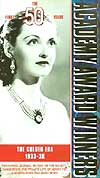
|
|
|
a main division within the plot of a film; a film is often divided by 'plot points' (places of dramatic change) rather than acts; long films are divided mid-way with an intermission | |
|
|
(1) any movement or series of events (usually rehearsed) that take place before the camera and propel the story forward toward its conclusion; (2) the word called out (by a megaphone) at the start of the current take during filming to alert actors to begin performing; (3) also refers to the main component of action films - that often contain significant amounts of violence |
 A megaphone to call out the word "ACTION" |
|
|
refers either to a male performer, or to any male or female who plays a character role in an on-screen film; alternate gender-neutral terms: player, artist, or performer |
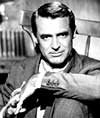 Cary Grant |
|
|
refers to any female who portrays a role in a film |
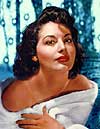 Ava Gardner |
|
|
the presentation of one art form through another medium; a film based upon, derived from (or adapted from) a stage play (or from another medium such as a short story, book, article, history, novel, video game, comic strip/book, etc.) which basically preserves both the setting and dialogue of the original; can be in the form of a script (screenplay) or a proposal treatment |  Who's
Afraid of Virginia Woolf? (1966) is a very faithful rendering or
adaptation of Edward Albee's play of the same name; also, Gone
With the Wind (1939) was adapted from Margaret Mitchell's novel,
and Apocalypse Now (1979) was taken from
Joseph Conrad's Heart of Darkness. Who's
Afraid of Virginia Woolf? (1966) is a very faithful rendering or
adaptation of Edward Albee's play of the same name; also, Gone
With the Wind (1939) was adapted from Margaret Mitchell's novel,
and Apocalypse Now (1979) was taken from
Joseph Conrad's Heart of Darkness. |
|
|
a line of dialogue improvised by an actor during a performance; can be either unscripted or deliberate; improvisation consists of ad-libbed dialogue (and action) that is invented or created by the performer | |
|
|
a camera shot filmed in an exterior location from far overhead (from a bird's eye view), as from a helicopter (most common), blimp, balloon, plane, drone or kite; some aerial shots use miniatures, or are created with CGI (digitally); a variation on the crane shot; if the aerial shot is at the opening of a film, aka an establishing shot |
 Examples:
the hunting scene in Tom Jones (1963), the helicopter raid
in Francis Ford Coppola's Apocalypse Now
(1979),
the title card for Dr. Strangelove, Or: (1964)
(see above), or the opening aerial shot of Manhattan in West
Side Story (1961), of Polanski's Rosemary's
Baby (1968), and in American Beauty (1999) and Mulholland
Dr. (2001). Examples:
the hunting scene in Tom Jones (1963), the helicopter raid
in Francis Ford Coppola's Apocalypse Now
(1979),
the title card for Dr. Strangelove, Or: (1964)
(see above), or the opening aerial shot of Manhattan in West
Side Story (1961), of Polanski's Rosemary's
Baby (1968), and in American Beauty (1999) and Mulholland
Dr. (2001). |
| See typecasting | ||
|
|
the pseudonym used by directors who refuse to put their name on a film and want to disassociate themselves, usually when they believe their control or vision has been co-opted by the studio (i.e., the film could have been recut, mutilated and altered against their wishes); aka Alan Smithee Jr., Allan Smithee, or Allen Smithee |  Examples:
Death of a Gunfighter (1969), Let's Get Harry (1986), The
Shrimp on the Barbie (1990), and the last film with the ironic alias:
An Alan Smithee Film: Burn, Hollywood, Burn (1997). Examples:
Death of a Gunfighter (1969), Let's Get Harry (1986), The
Shrimp on the Barbie (1990), and the last film with the ironic alias:
An Alan Smithee Film: Burn, Hollywood, Burn (1997). |
|
|
usually refers to top-tier actors/actresses who are paid upwards of $20 million per feature film; can also refer to producers, directors and writers who can be guaranteed to have a film made and released | Examples: actors/actresses Tom Hanks, Julia Roberts, Brad Pitt, Jodie Foster, or directors George Lucas and Steven Spielberg |
|
|
mostly a literary term, but taken in film terms to mean a suggestive resemblance or correspondence between a visible event or character in a film with other more significant or abstract levels of meaning outside of the film; an extended metaphor | Examples: Metropolis (1927), Animal Farm (1955), The Seventh Seal (1957), The Piano (1993), Eat Drink Man Woman (1994), The Matrix (1999); also Biblical or Christ-related allegories. |
|
|
a direct or indirect reference - through an image or through dialogue - to the Bible, a classic, a person, a place, an external and/or real-life event, another film, or a well-known cultural idea | 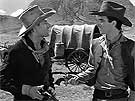 Example:
In Red River (1948), Montgomery Clift (as
Matt Dunson) and John Ireland (as Cherry Valance) show off their guns to
each other and ask: "You know, there are only two things more beautiful
than a good gun: a Swiss watch or a woman from anywhere. You ever had a
good Swiss watch?" - a scene often interpreted as alluding to homosexuality Example:
In Red River (1948), Montgomery Clift (as
Matt Dunson) and John Ireland (as Cherry Valance) show off their guns to
each other and ask: "You know, there are only two things more beautiful
than a good gun: a Swiss watch or a woman from anywhere. You ever had a
good Swiss watch?" - a scene often interpreted as alluding to homosexuality |
|
|
the shooting (or re-shooting) of a film's ending for its theatrical release, usually enforced by the studio for any number of reasons (because of test audience preview results, controversial or unpopular subject matter, to provide a 'happy' ending, etc.). See also director's cut | Examples: The Magnificent Ambersons (1942), Kiss Me Deadly (1955), Invasion of the Body Snatchers (1956), Blade Runner (1982), Little Shop of Horrors (1986), Fatal Attraction (1987), and Army of Darkness (1993). |
|
|
the feeling or mood of a particular scene or setting | |
|
|
the natural light (usually soft) or surrounding light around a subject in a scene; also see background lighting | |
|
|
a situation, story-line, scene, or character, etc. in which there are apparent contradictions; an event (and its outcome) is deliberately left unclear, and there may exist more than one meaning or interpretation; can be either intentional or unintentional, to deliberately provoke imaginative thinking or confusion | Example: Robert Altman's 3 Women (1977) |
|
|
an element or artifact in a film that belongs to another time or place; often anachronistic elements are called film flubs | Example: Star Wars Episode II: Attack of the Clones (2002), the first feature 'film' shot using digital video cinematography, isn't really a film - an anachronistic term in this case; in the Civil War film, Glory (1989), one of the kids in the film wears what appears to be a Swatch watch; or in Lawrence of Arabia (1962), a U.S. Browning air-cooled machine gun is oddly featured before its time; or the use of 1873 Colt Peacemakers in Red River (1948) |
|
|
related to different optical imaging effects; refers to a method of intentionally distorting and creating a wide screen image with standard film, using a conversion process or a special lens on the camera and projector to produce different magnifications in the vertical and horizontal dimensions of the picture; an anamorphic image usually appears "squished" horizontally, while retaining its full vertical resolution; see also aspect ratio and the trade name CinemaScope. Many studios produced anamorphic lenses, using other trade names such as Panavision, Technovision, and Technirama. On the right are examples of anamorphic imaging effects from the film Blade (1998) (with an aspect ratio of 2:35.1). |
|
|
|
contractual agreement in which a percentage of the profits are received by individuals, or derived from the sale of action figures, posters, CDs, books, T-shirts, etc. |
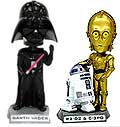 Collectible ancillary products - custom-molded, hand-painted, polyresin bobblehead dolls of the characters from Star Wars (1977). |
|
|
refers to the perspective from which a camera depicts its subject; see camera angle, and other specific shots (high, low, oblique, etc.); angle on refers to directing the camera to move and focus onto a specific subject |
 A camera angled slightly upward |
|
(and animator, animated films) |
a form or process of filmmaking in which inanimate, static objects or individual drawings (hand-drawn or CGI) are filmed "frame by frame" or one frame at a time (opposed to being shot "live"), each one differing slightly from the previous frame, to create the illusion of motion in a sequence, as opposed to filming naturally-occurring action or live objects at a regular frame rate. Often used as a synonym for cartoons (or toons for short), although animation includes other media such as claymation, computer animation; see also CGI, claymation, stop-motion, time lapse |
 A
still from Disney's full-length animated feature film, Snow
White and the Seven Dwarfs (1937). A
still from Disney's full-length animated feature film, Snow
White and the Seven Dwarfs (1937). Also the hand-drawn colorful laser-beams in the Star Wars films. |
|
|
a distinctive style of animated film that has its roots in Japanese comic books (known as manga), yet covers a wide range of genres, such as romance, action/adventure, drama, gothic, historical, horror, mystery, erotica (hentai), children's stories, although most notably sci-fi and fantasy themes; originally called 'Japanimation' but this term is not used anymore; anime is found in a wide variety of storylines and settings, but usually recognizable and often characterized by heavily-stylized backgrounds, colorful images and graphics, highly exaggerated facial expressions with limited facial movement, simulation of motion through varying the background behind a static character or other foreground element, and frequently, big-headed characters with child-like, large eyes |
 Examples:
Anime began in the early 1900s, but was more developed by the 1970s, entered
into the mainstream in Japan in the 1980s, and was more widely accepted
internationally beginning in the 1990s. Recent examples include director
Hayao Miyazaki's Princess Mononoke (1997), Spirited Away (2001)
and Howl's Moving Castle (2004) (pictured). Examples:
Anime began in the early 1900s, but was more developed by the 1970s, entered
into the mainstream in Japan in the 1980s, and was more widely accepted
internationally beginning in the 1990s. Recent examples include director
Hayao Miyazaki's Princess Mononoke (1997), Spirited Away (2001)
and Howl's Moving Castle (2004) (pictured). |